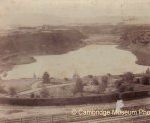Cambridge Collections
Cambridge Domain Board and Paths

On 15 June 1880 reserve lands in New Zealand were brought under the Public Domains Act 1860 and the first Cambridge Domain Board was appointed.
The first meeting was held 3 July 1880 when Thos Wells was elected chairman, a position he held until 3 May 1905 – nearly 25 years.
The Domain Board was to administer about 700 acres of waste land, much of it valueless for any purpose, the whole of it covered with gorse, briar, ti-tree and fern, while the banks of the lake were covered with tons of the town’s rubbish.
The members of the board borrowed £200 from the bank, on their personal securities, and hired John Gwynneth to survey the whole domain land for £160 in August 1880. Most of the sections were advertised for 21 years lease by public auction.
In 1882 the powers that were decided to drain the township into Te Koutu Lake. William Reid wrote to the Waikato Times “. . . if the main sewer is delivered into the lake, it will turn what is now a beautiful sheet of pure spring water into a filthy pond which will be a public nuisance and cause disease and death”. The suggestion of draining into ‘the creek’ went unheeded even though water from Te Koutu was used in summer for household purposes when spring water was scarce.
In July 1884 Mr Purdie (landscape gardener) was engaged to lay off Te Koutu reserve and by 1885 the gardener, Thomas S Brown, had laid down walks, sowed grass and planted out over 3,000 trees and shrubs. The Pearson Brothers of Tamahere and Mr Coombes had donated 50 horse chestnuts, 50 elms and the gum trees by the railway, and a nursery was established in the middle of the Domain.
New Year’s day of 1886 saw water polo on the lake with profits going to buy more trees and at the same time boats were given the right of way over ducks.
In 1887 Thomas Wells introduced golden carp and Alfred G Hughes released 3 dozen American cat fish. Lewis & Simpson donated two garden seats made by the Falkirk Iron Company.
From 1885 to 1901 the work of the Board consisted mainly of the upkeep of the park borders etc, previously made and planted. They brought the area from Victoria Road to the back of the rosary into park and gardens, and in 1898 landscaper Charles W S Purdie’s plan to camouflage the old gravel pit and incorporate a sunken bowling green and tennis court for £21 plus £90 labour, was accepted.
The Board helped with building the pavilion, clearing the lake banks from time to time, and fencing and planting in Cambridge West.
Various pathways in Cambridge Domain, are named to honour the chairmen of the Cambridge Domain Board.
Tom Wells (general store owner) was the first Cambridge Domain Board chairman, serving from its inception in 1880 until 1905. He put in twenty-five years of dedicated hard work to fulfil a dream of beautifying the Cambridge Domain and developing Lake Te Koutu from a howling wilderness.
The other committee members were James P Campbell, Robert Kirkwood, John Fisher and E B Walker and on their own surety they borrowed £200 to resurvey the 700 acres of reserve land. Then with the rent from leases they were able to beautify the domain area.
After Thomas Wells’ death in 1910 funds were raised by the people of Cambridge to erect the Thomas Wells Memorial Gates as a tribute to him.
W Frank Buckland (solicitor) had a year at the helm in 1905-1906 when the Auckland Acclimatisation Society members were given permission to shoot shags.
John Ferguson (wheelwright) became the next chairman from 1907-1928 having also spent eight years on the committee and twenty years on the Cambridge Borough Council.
In 1919 an Arboreal Committee was also formed to assist further improvements and under the leadership of Richard Reynolds they planted numerous trees not just in the Domain but all around the town.
Sam Lewis (solicitor) took over the reins of the Domain Board in 1928 after a stint as Mayor from 1921-1923 and councillor from 1909-1912 and 1913-1915. (He was a councillor again from 1944-1953).
In 1929 the Domain Beautifying Society, with Mr George Clark (patron and life member of the Bowling Club) as chairman, was founded to assist the Board in maintaining the Domain.
In 1929 James Hooker also made a generous gift of the ornamental entrance around the Tom Wells Memorial Gates making this a unique ‘welcome’ to the domain.
In the minutes of 16 May 1933 it is recorded that Sam Lewis spoke in highest praise of the valuable work the unemployed were doing in clearing the growth from out of the lake.
Just as an aside, the minutes of 7 February 1934 makes the note, “It was decided that the Police be asked to be present when Band Concerts are in progress”.
In 1936 Mr G M Watt proposed a gate commemorating the Borough Council Jubilee, be built opposite the Kiosk.
William J White was the fifth chairman of the Domain Board from 1942 until his death in 1953 when Wilfred Omerod Cubis was elected.
The Cambridge Borough Council took over the running of all the parks and reserves after the Reserves and Domains Act 1953.
Mr Cubis stated at the Council’s first Domain Board meeting, 31 August 1954 that the work of the former Domain Board had been slipping back for some years, due entirely to lack of finance. He considered that the new board with greater resources at its command should be able to bring the domain to its former good state, and maintain it so.
A new body – Te Koutu Lake Improvement Society – then went into action with F H ‘Bert’ Short, Jack Robinson and G E Houghton taking the lead in improving the Albert Street end of the lake.
